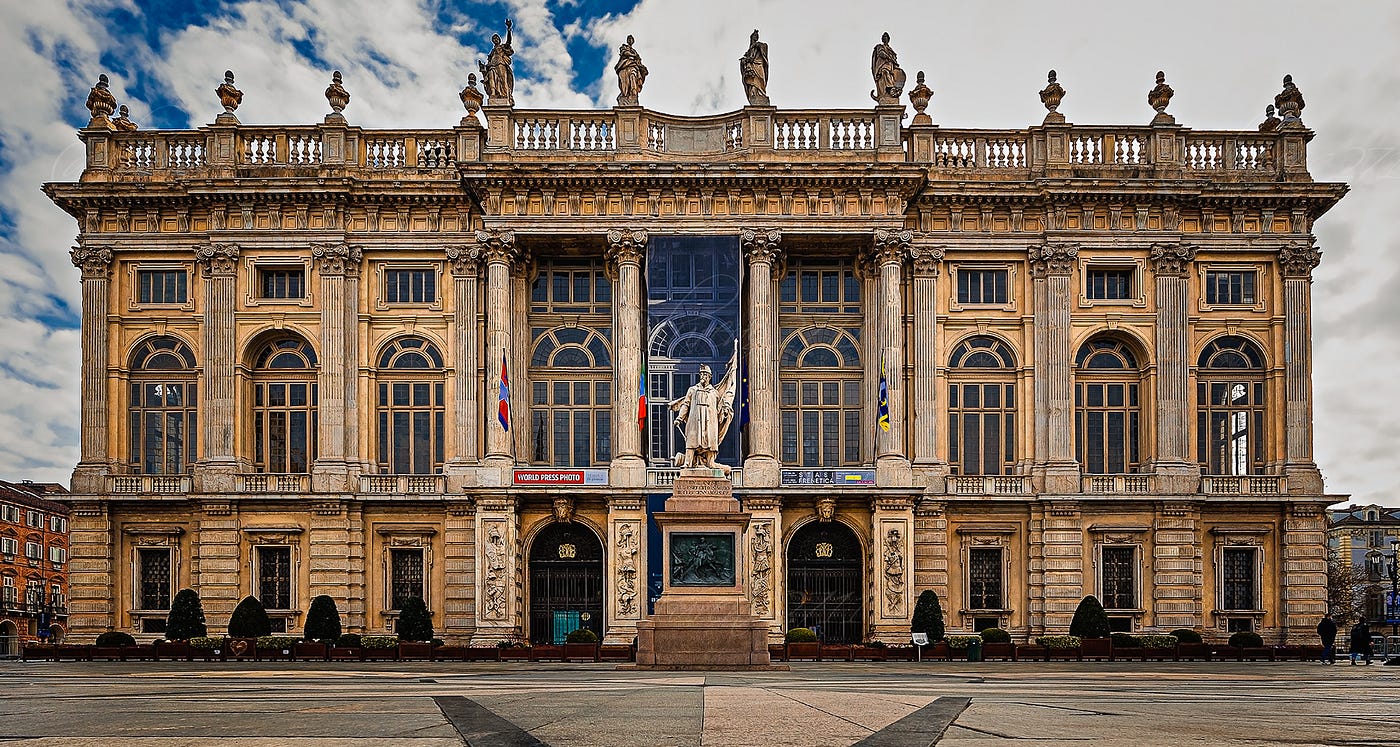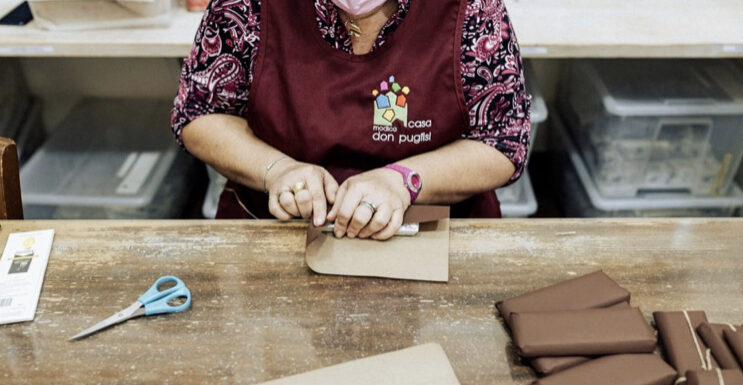With Valentine’s Day, thoughts turn to chocolate. Here’s an excerpt from “100 Places in Italy Every Woman Should Go” to help you find the best places for chocolate in Italy…
“Let them eat chocolate,” was the kind proclamation of Madama Reale.

The year was 1678. Madama Reale was thirty years old, widowed, with a boy to raise, and had become the ruler of the Piedmont region in northern Italy. She took her job seriously and carried on major beautiful changes to the city during her reign , continuing in the tradition her husband had began, remodeling the Palazzo Madama into pretty French style.

In Madame Reale’s day chocolate was a precious novelty served only to royalty and priests. It had come to Italy through the Spanish explorer Cortez, who found it in South America.
When a Turin baker asked Madame Reale’s permission to make chocolate for regular folk, I imagine she figured, “Why not?” She probably needed the seritonin fix to deal with the hassles of being a female ruler and wanted to pass on the high to keep her popularity ratings up.

The baker began making hot chocolate — a drink called bicerin that’s still “what to order” in Turin caffès today. A love affair with chocolate began and Turin became Europe’s top producer, even inventing a machine that made the world’s first candy bars.
Italy’s chocolate-making tradition has continued ever since. So you can thank Madama Reale as you visit some of my favorite chocolate shops in Italy:
Rome: Moriondo & Gariglio, Via del Piè di Marmo 21–22 (near Pantheon)

This fairy tale-styled shop near the Pantheon was founded by a family from Turin over a hundred years ago. Sales signorine wear old-fashioned lace caps and box up bon-bons, marzipans, or fruit glaces into beautifully crafted boxes at an old world pace…so don’t say I didn’t warn you.
Florence: Vestri, Borgo degli Albizi 11r (near Santa Croce), www.vestri.it

There’s a lively energy at this tiny shop where molto bello owner Leonardo doles out treasures that include chocolates made with flavors like Earl Grey and chile, along with thick hot chocolate. The gelato here is fantastico, which you should order affogato, topped with to-die-for chocolate sauce. Candies are packaged in Tiffany-blue boxes and make great gifts.
Tuscany: The Chocolate Valley
The most exciting developments in Italy’s chocolate scene are happening in an area bordered by Prato and Pisa, where since the 1980s artisans have taken on chocolate production like meticulous Tuscan winemakers. It all started with Roberto Catinari in Agliana, Pistoia, and now includes Andrea Slitti in Monsummano Terme, and Luca Mannori in Prato.
The most well known among them is Amedei, whose factory outside Pontedera has become so successful it sells to specialty food shops worldwide.

Creators behind Amedei were Cecilia Tessieri, the first woman in the world to become a Maitre Chocolatier, and her brother Alessio, who took care of the business side. They were children of Tuscan candy makers with no chocolate experience, who decided to give it a go over thirty years ago, experimenting with great dedication. In 1991, they brought their findings to the pinnacle of the chocolate world, Valrhona in France, and tried to partner with them. Valrhona flatly turned them down.
Insulted but not discouraged, Alessio set out to find the best beans he could to make Amedei chocolate. In Chuao, Venezuela, where a perfect microclimate supports excellent cacao, Alessio took a risk. He offered the farmers three times as much as what Valrhona had been paying them. Now all of Chuao’s cacao goes to Amedei. It’s what’s called Sweet Revenge.
In 2020 Cecilia Tessieri Rabassi (her married name), left Amedei to create a chocolate workshop in the province of Pisa.

She makes amazing chocolates, with innovative methods — such as pampering the cocoa in basins made of alabaster, a rock common to nearby Volterra.
Venice: Vizio Virtù, Calle del Forner 5988, Castello (near Rialto) www.viziovirtu.com

Award-winning Mariangela Penzo is the master chocolatier of this shop that opened in 2005. Her scrumptious artistic creations include chocolate flavored with pumpkin, artfully designed candies, and hot chocolate, which makes this a fun place to snuggle into on a chilly Venice day. Tastings and chocolate workshops can be arranged.
Naples, Gay-Odin, 9 locations in the city

Isidoro Odin (from northern Alba) began this chocolate making enterprise in 1894. Naples was then a city where aristocrats, artists, and writers (including Oscar Wilde) gathered, and they became fans of Odin’s handcrafted goodies. The tradition of high quality remains, and the packaging, with scenes of Naples, makes these chocolates delicious souvenirs.
Perugia: Home of Baci, www.perugina.it
This artsy town in Umbria, aka City of Chocolate, is home to the famous Perugina chocolate company that’s now owned by Nestlé.

Perugina goodies abound around here, and you may want to head out to the suburban factory for chocolate-making classes, along with tours, a gift shop, and chocolate museum.
Baci, Perugina’s most famous chocolates, were invented in 1922 by Luisa Spagnoli, and were an immediate hit when first introduced that Valentine’s Day.

Luisa, the wife of Perugina’s founder, fell in love with the much younger Giovanni Buitoni, who also worked at Perugina. She’d write secret love notes on the chocolates she sent to Buitoni for inspection. When she died he renamed her chocolates Baci (which means kisses) and had them packaged with romantic musings, in memory of those notes. Which is why when you unwrap one, you’ll find such Luisa sayings as: Non esiste salvaguardia contro il senso naturale dell’attrazione (There is no safety-net to protect against attraction). Luisa was also the inspiration for those beautiful Luisa Spagnoli clothing stores you’ll find all over Italy.
Mastro Cianuri, Piazza Matteotti 17, Perugia
This sweet family run business began with creating gelato in 1980, and when the owner’s daughters joined in, chocolate making was added to match their passions.

The shop in the historic center includes a sidewalk caffe, welcoming locals and tourists, and they offer fun curated tastings.
Eurochocolate, the world’s largest international chocolate festival, is held in Perugia every year. For details: www.eurochocolate.com
Modica: Sicily’s Chocolate Center
This pretty baroque town in southeastern Sicily is famous for its Aztec-style chocolates that are granular, like what you’d find in Mexico. Its origins go back to seventeenth century Spaniards who brought over the tradition of grinding cocoa beans to a paste that’s mixed with cane sugar, cinnamon, or other spices.
Top shops in Modica are
Bonajuto (Corso Umberto I 159, www.bonajuto.it), that’s been around since 1880, and
Casa Don Puglisi (Corso Umberto 1, www.laboratoriodonpuglisi.it), created by former pastry chef Lina Lemmolo.

Don Puglisi is not only a chocolate shop, but also a community organization, providing help and jobs to impoverished women and children, so that their lives are turned around through chocolate-making.
Turin: Back to Where It All Began
Grace Kelly loved gianduiotti, the chocolate-hazelnut candies of Turin, so much she used them as her wedding favors when she married Prince Rainier.

The creamy candy was invented during a nineteenth-century recession, when cocoa imports were limited. Clever candy makers figured out how to blend the little cocoa they did have with the plentiful hazelnuts that grow all over the region. Thus came Nutella and the triangular shaped chocolate, that got its name (gianduiotti), from the commedia character, Gianduja, who always wore a triangle-shaped hat. Caffarel company patented the candies in 1865, and the rest is delicious history.
Peyrano (Corso Vittorio Emanuele 76, www.peyrano.com), near Turin’s train station, has been around for almost a hundred years and serves up fantastic gianduiotti and dark chocolate that’s roasted in olive wood.
Guido Gobino Shops in Torino and Milan, www.guidogobino.it

This superstar chocolate artisan is praised internationally for his innovative flavors, and chocolate making approach that blends new ideas and sustainable practices while respecting tradition. Guido Gobino chocolates are beloved worldwide, and he’s partnered with Armani/Dolci to create an exclusive line of chic sweets.

For more ideas to enhance your Italian travels…

OR come along with me for a Golden Week in Italy: For Women Only — Chocolate Is ALWAYS Included! Still places available for 2024 — CLICK HERE for info



